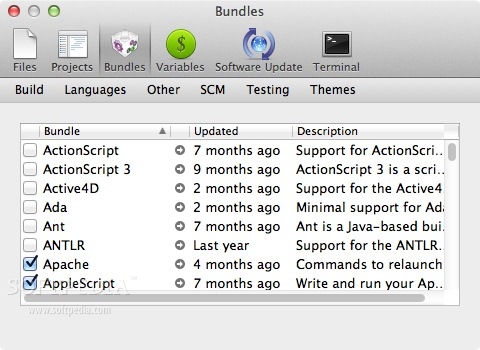

Things like gcc, g++, gdb, make, strip, etc, etc. Once you’ve done that, you’ll have all your favourite stuffs in the default search path, and hence easily accessible in the shell.
#TEXTMATE 2 BINARY INSTALL#
Go to Preferences, Downloads tab, then click and install Command Line Tools.
#TEXTMATE 2 BINARY DOWNLOAD#
usr/bin), you need an additional download of the Command Line Tools from within Xcode. So to conveniently have all your favourite GNU C compiler and other support tools directly available in the standard location (i.e. Nowadays, the Xcode command line tools are hidden away within the application.
#TEXTMATE 2 BINARY SOFTWARE#
Xcode is a suite of tools for developing software on OS X.

Go to the Mac App Store and download Xcode. What about compilers and, well, the real programming stuffs? Well, it’s a free download, or two, away. There’s rsync too, if you need to keep directory trees in sync. If you need to login to a Unix host, or copy files back and forth, both ssh and scp are already in there. You’ll feel totally at home if you came from a Unix programming environment. Scripting languages like Perl, PHP, Python, and Ruby. For example, editors like vi (my favourite!) and nano. You’ll be glad to note that many command line tools are already included in OS X. I’m not trying to write a Dummies Guide to the Unix Shell in here, so at this point, if you feel totally lost, I’d advise you to Google around for some good tutorials. This is the bash shell, so it’s as true to a Unix shell as you can get (and totally unlike the Command Prompt you get in Windows). If you like, drag the Terminal app to your Dock, so that it’s more easily accessible in future. Or, just spotlight (Cmd-Space) for Terminal. The shell, or command line, is accessible via Applications -> Utilities -> Terminal. The sort of thing that an introductory programming course at university level would expect you to do.įirst thing is that you’ll be pleased to know your Mac already comes, out-of-the-box, with a Unix shell environment and plenty of command line tools. Yes, I know, there are wonderful GUIs and IDEs. I’m writing this post to help people get started using their Macs for programming, particularly in a back-to-basics environment using a Unix shell with command line tools and such. While it is arguably not alien from a Linux platform, there are indeed differences, yet at the same time, there are similarities. It’s definitely a whole lot better than Windows. Oh, maybe there needs to be some prep work. Definitely an easier platform to start on. Well, the answer is mostly a resounding yes. Update: There a new edition of this post - Setting Up Your Mac For Programming. Surely there must be a good reason why they’re loving the Mac platform too? Definitely, right? After all, you have heard that system administrators and programmers also love the Mac. But you know your Mac can do programming too. That’s what many people go to the Mac for.

The fun stuff and the life stuff, if you know what I mean. The Mac is well known for doing photos, graphics, movies, and music.


 0 kommentar(er)
0 kommentar(er)
